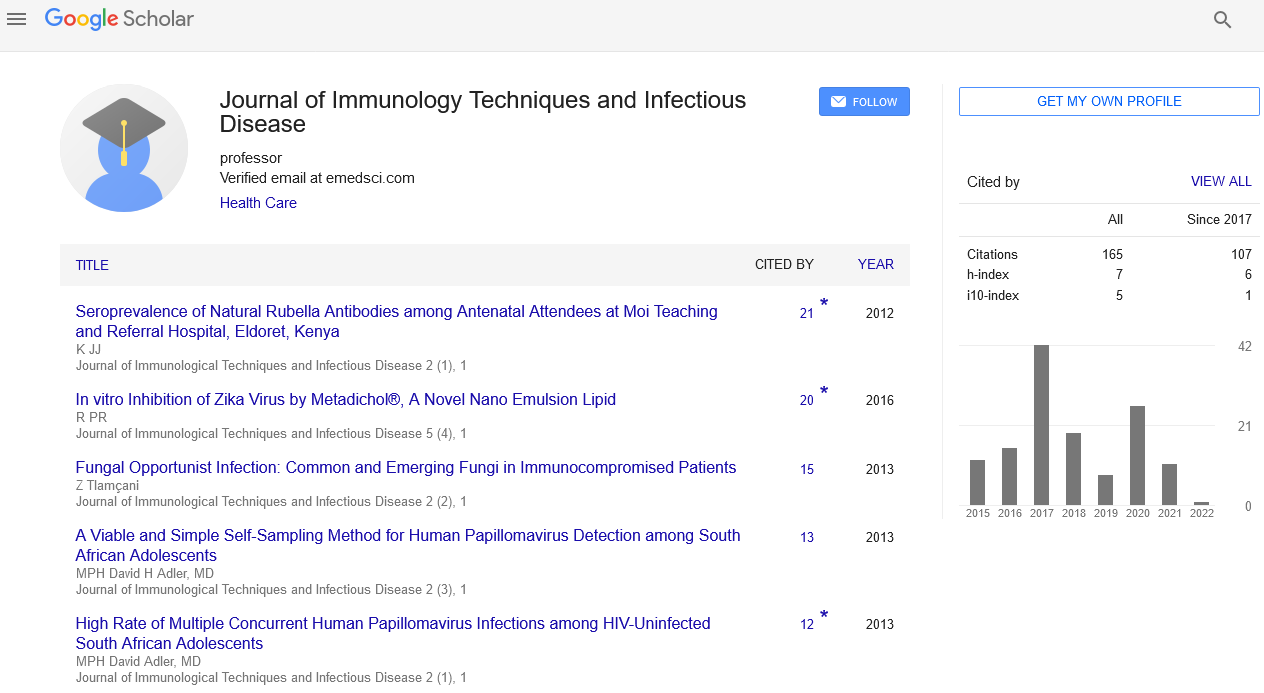Short Communication, J Immunol Tech Infect Dis Vol: 10 Issue: 4
The effect of G lucidum on the lifespan of Caenorhabditis elegans modeling Duchenne muscular dystrophy
Duchenne muscular dystrophy (DMD) is an X chromosome-linked disease characterized by progressive physical disability, immobility and premature death in affected boys. Underlying the devastating symptoms of DMD is the loss of dystrophin, a structural protein that connects the extracellular matrix to the cell cytoskeleton and provides protection against contraction-induced damage in muscle cells, leading to chronic peripheral inflammation. However, dystrophin is expressed in neurons within specific brain regions, including the hippocampus, a structure associated with learning and memory formation. Linked to this, a subset of boys with DMD exhibit progressing cognitive dysfunction, with deficits in verbal, short-term, and working memory. Furthermore, in the genetically comparable dystrophin-deficient mouse model of DMD, some, but not all, types of learning and memory are deficient and specific deficits in synaptogenesis and channel clustering at synapses has been noted. Little consideration has been given to the cognitive deficits associated with DMD compared with the research conducted into the peripheral effects of dystrophin deficiency. Therefore, this review focuses on what is known about the role of full-length dystrophin (Dp427) in the hippocampal neurons. In this experiment, I hypothesized that 100 ug/ml of G. Lucidum would extend the lifespan and too much concentration of this herbal medicine would lose its efficacy in treating this disease. A study was conducted through the reactions and lifespan of Caenorhabditis Elegans exhibiting the lack of dystrophin to the different concentrations of G. Lucidum. As a result, the effect of G. Lucidum on the Caenorhabditis Elegans modeling Duchenne Muscular Dystrophy was astonishing as 100 ug/ml of G. Lucidum helped prolong the lifespan of these nematodes by 20%. This data can be reflected onto the lifespan of humans with DMD as the 20% increase in lifespan of these nematodes could mean the prolonged life of 6-8 years for humans. However, too much concentration of G. Lucidum was shown not to affect the life of the worms. The hypothesized argument was proven correct as the results show the 20% increase of lifespan for the 100 ug/ ml of G. Lucidum concentration and the effect of too much concentration of this herbal method. Moreover, the use of herbal medicine like G. Lucidum could be a new inexpensive and attainable method of treatment for those diagnosed with DMD. The importance of dystrophin in learning and memory is assessed, and the potential importance that inflammatory mediators, which are chronically elevated in dystrophinopathies, may have on hippocampal function is also evaluated.
Abstract
Duchenne muscular dystrophy (DMD) is an X chromosome-linked disease characterized by progressive physical disability, immobility, and premature death in affected boys. Underlying the devastating symptoms of DMD is the loss of dystrophin, a structural protein that connects the extracellular matrix to the cell cytoskeleton and provides protection against contraction-induced damage in muscle cells, leading to chronic peripheral inflammation. However, dystrophin is expressed in neurons within specific brain regions, including the hippocampus, a structure associated with learning and memory formation. Linked to this, a subset of boys with DMD exhibit progressing cognitive dysfunction, with deficits in verbal, short-term, and working memory. Furthermore, in the genetically comparable dystrophin-deficient mouse model of DMD, some, but not all, types of learning and memory are deficient and specific deficits in synaptogenesis and channel clustering at synapses have been noted. Little consideration has been given to the cognitive deficits associated with DMD compared with the research conducted into the peripheral effects of dystrophin deficiency. Therefore, this review focuses on what is known about the role of full-length dystrophin (Dp427) in the hippocampal neurons.
In this experiment, I hypothesized that 100 ug/ml of G. Lucidum would extend the lifespan and too much concentration of this herbal medicine would lose its efficacy in treating this disease. A study was conducted through the reactions and lifespan of Caenorhabditis Elegans exhibiting the lack of dystrophin to the different concentrations of G. Lucidum. As a result, the effect of G. Lucidum on the Caenorhabditis Elegans modeling Duchenne Muscular Dystrophy was astonishing as 100 ug/ml of G. Lucidum helped prolong the lifespan of these nematodes by 20%. This data can be reflected onto the lifespan of humans with DMD as the 20% increase in lifespan of these nematodes could mean a prolonged life of 6-8 years for humans. However, too much concentration of G. Lucidum was shown not to affect the life of the worms.
The hypothesized argument was proven correct as the results show the 20% increase of lifespan for the 100 ug/ ml of G. Lucidum concentration and the effect of too much concentration of this herbal method. Moreover, the use of herbal medicine like G. Lucidum could be a new inexpensive and attainable method of treatment for those diagnosed with DMD. The importance of dystrophin in learning and memory is assessed, and the potential importance that inflammatory mediators, which are chronically elevated in dystrophinopathies, may have on hippocampal function is also evaluated.
 Spanish
Spanish  Chinese
Chinese  Russian
Russian  German
German  French
French  Japanese
Japanese  Portuguese
Portuguese  Hindi
Hindi 
